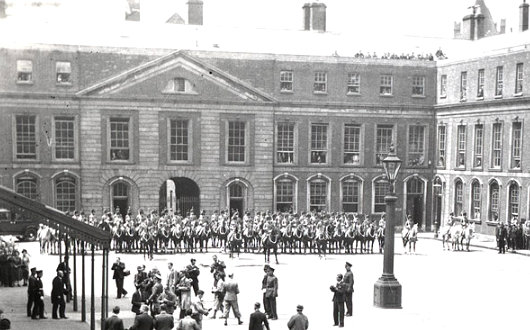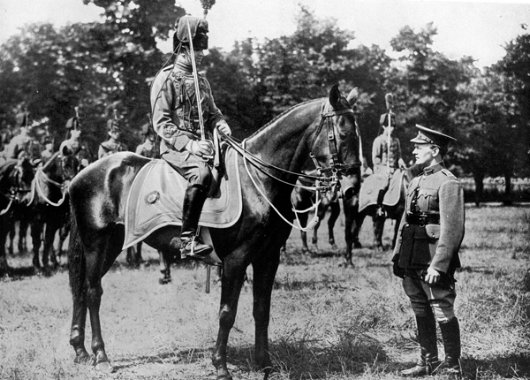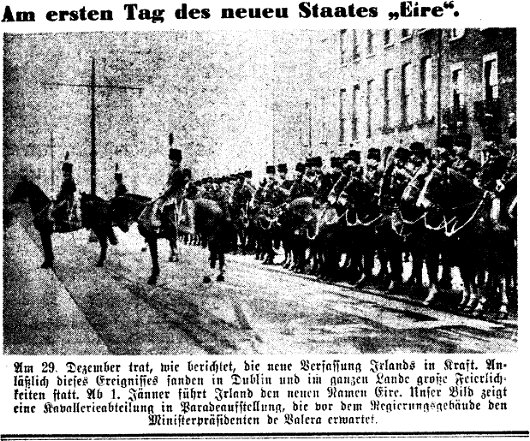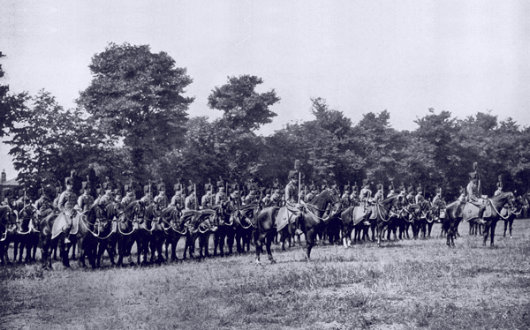
About Andrew Cusack
 Writer, web designer, etc.; born in New York; educated in Argentina, Scotland, and South Africa; now based in London.
Writer, web designer, etc.; born in New York; educated in Argentina, Scotland, and South Africa; now based in London. read more
News
Blogs
Reviews & Periodicals
Arts & Design
World
France
Mitteleuropa
Knickerbockers
Argentina
The Levant
Africa
Cape of Good Hope
Netherlands
Scandinavia
Québec
India
Muscovy
Germany
Academica
The Blue Hussars
Ireland’s Mounted Presidential Escort

 WHEN BRITAIN FINALLY granted dominion status to Ireland, her longest-held possession, in the 1920s it unfortunately also signalled the end to a long tradition of Irish service in H.M. Forces. Well, this is not entirely true — thousands of Irishmen from both Ulster and the Republic continue to volunteer for the Army, Royal Navy, and RAF (the Royal Irish Regiment and the Irish Guards receiving the lion’s share) with an exemplary record of service to the Crown. But numerous other regiments with long lineages rolled up their colours in a dramatic ceremony at Windsor Castle in 1922. (An aside: one of those five regiments was the Connaught Rangers whose former name — the 88th Regiment of Foot — inspired the later re-designation of a New York Guard unit as the 88th Brigade NYG, of which yours truly is a veteran and my uncle the former commander).
WHEN BRITAIN FINALLY granted dominion status to Ireland, her longest-held possession, in the 1920s it unfortunately also signalled the end to a long tradition of Irish service in H.M. Forces. Well, this is not entirely true — thousands of Irishmen from both Ulster and the Republic continue to volunteer for the Army, Royal Navy, and RAF (the Royal Irish Regiment and the Irish Guards receiving the lion’s share) with an exemplary record of service to the Crown. But numerous other regiments with long lineages rolled up their colours in a dramatic ceremony at Windsor Castle in 1922. (An aside: one of those five regiments was the Connaught Rangers whose former name — the 88th Regiment of Foot — inspired the later re-designation of a New York Guard unit as the 88th Brigade NYG, of which yours truly is a veteran and my uncle the former commander).
The forces which became the Irish Free State Army, given their irregular nature, lacked a ceremonial tradition (though, had I been around and Michael Collins invited me to do so, I would’ve happily manned the desk in the IRA Office of Protocol, Ceremony, and Feathery Hats). In 1932, Dublin hosted the International Eucharistic Congress — a big event in those days, sadly reduced in stature — which meant that dignitaries of great importance would take this opportunity to visit the Irish capital.

And so, the Mounted Escort was formed in 1932 to escort the Papal Legate during the Eucharistic Congress, but given the colour and cut of their uniforms, they quickly acquired the nickname of ‘the Blue Hussars’. Originally, the artist Seán Keating headed up a committee to design a uniform in a suitably modern-but-Celtic style, as was the general artistic bent of the Irish state at the time. Keating’s design called for a saffron léine tunic with six rows of black braid, black cuffs, a blue brat cloak, pantaloons, and a black Balmoral bonnet with saffron feather.
The Army decided not to go with Keating’s proposal but instead adopted the uniform of the 8th King’s Royal Irish Hussars: blue tunic & breeches, yellow frogging & lace, and black sealskin busby with yellow-orange plume. The only difference was that the 8th used dark blue, while the Blue Hussars went for a sapphire blue. Rumour at the time was that when the unit was being formed, a bunch of 8th King’s Royal Irish Hussars uniforms were discovered in a closet in Dublin Castle and it was decided to use them, but record actually exists of the purchase of seventy uniforms for the Mounted Escorts.

Ireland adopted a new constitution that introduced a presidency and reduced the role of the King of Ireland to the very barest essentials of the head of state: signing the letters of credence accrediting Irish ambassadors to foreign states, and signing international treaties on Ireland’s behalf. Almost all other duties that a head of state might have were transferred to a new President who fulfilled the internal role while the King maintained the external role. (Furthermore, the ‘Irish Free State’ was abolished and ‘Éire’ was born). Professor Douglas Hyde, the Protestant founder of Conradh na Gaeilge, was selected as the first President of Ireland and inaugurated at Dublin Castle in June, 1938. From that time, the Blue Hussars became the Mounted Escort to the President of Ireland.
When President Hyde retired in 1945, he was succeeded by Seán T. O’Kelly, who was escorted to his inauguration in an open landau through the streets of Dublin. In 1947, the government of Taoiseach Éamon de Valera abandoned the use of carriages by the President after a carriage accident at the Dublin Horse Show (whose official patron, incidentally, was still H.M. the King of Ireland). The following year, under the Inter-Party Government, the Blue Hussars were abolished altogether, as it was decided to shift to motorcycles under the ridiculous excuse from the Ministry of Defence that they would be more impressive than horses. It was also widely used as an excuse that there was a lack of suitable horses — in Ireland! And so, after the Republic of Ireland was proclaimed in 1949, the heads of state of Great Britain and France continued to enjoy escorts of Irish horses while Ireland made do with foreign-built motorcycles.
2 Cavalry Squadron, the Army motorcycle unit which now escorts the President of Ireland, has inherited the nickname of the Blue Hussars, and in 1997 received blue motorcycles in a nod towards the tradition. It seems shameful though — especially considering that the Irish Army School of Equitation continues to train international-quality horsemen — that the Blue Hussars have not been revived.

Search
Instagram: @andcusack
Click here for my Instagram photos.Most Recent Posts
- Bicycle Rack April 29, 2024
- Burns Tower April 19, 2024
- Patrick in Parliament March 18, 2024
- Articles of Note: 13 March 2024 March 13, 2024
- Cambridge March 9, 2024
Most Recent Comments
Book Wishlist
Monthly Archives
Categories



The Blue Hussars were in fact part of the Artillery Corps (‘The Premier Corps’) as opposed to the Cavalry Corps. The half-hearted attempt to revive them after 1945 was hampered by the Fianna Fáil Government’s penny-pinching attitude and an aversion within the Civil Service to what was regarded as a ‘British-type’ formation. Recently, it was suggested that the Equitation School should fall victim to a raft of Irish Government cuts, but this has gone no further than a suggestion.
Always thought it a great pity too that the battle honours, so valiantly gained, of those fine old Irish Regiments disbanded in 1922 aren’t borne on the colours of present day Irish infantry Bns.
“An aside: one of those five regiments was the Connaught Rangers whose former name — the 88th Regiment of Foot — inspired the later re-designation of a New York Guard unit as the 88th Brigade NYG, of which yours truly is a veteran”
So you have been in the military, Andrew?
Thank you for researching this history. My Father, David Caffrey is 73 years old and is always mentioning That his Father Sean/John/Jack Caffrey(I.R.B old I.R A lived to be a great age) brought his son, my father david/dave to the Phoenix Park to see the Blue Huzzars on parade and manovuers, in practice. He is very moved by this (helped by the wine) So I will show him this wonderful arcival materials. Thank you .
I have a picture of my Farther in the Blue Huzzars Uniform and would like any information posible of the regiment
I also have a photo of my father(Eugene ‘Gene’ Brannigan) in the Huzzars Uniform, he was 21 years old at the time of the Eucharistic Congress. My mother spoke of what a hot day it was that June. I wonder if there are any plans to pay tribute to them at the forthcoming Eucharist Congress.
my dad Joseph always said he was in the Blue Huzzars- as was his brother. Theirs names were Jack and Joseph Nugent..would love to know more about it. kind regards, theresa
Sir,My late father,John James Moran joined the Army of The Irish Free State in about 1942-43 at Dublin.He initially joined the transport corps,which was then nearly all horse drawn.He later joined the Blue Hussars as a trooper.I recall him telling me that he rode in the Presidents parade of 1945. He also told me that all troopers were responsible for the welfare of two horses when in barracks,his being horses 1049 and 1050,the horses army numbers.He recalls an old horse being in the stables whom they called “The Major”.This horse would be stabled for the night,as were the others,then in the morning all the horses would be wandering about the stable,having been let out during the night by”The Major”.My father left the army in about 1948-9.
I am a student of the evictions on the Vandeleur estate, Kilrush, July 1888, in which a contingent of 50 3rd Hussars played a supporting role. The King’s Own was then stationed in Cahir, county Tipperary, and a contingent under the command of Captain Duncan Vernon Pirie was sent to Kilrush for a month to provide additional security for the eviction force. I am looking for photographs of their encampment on the grounds of the Kilrush House. Alone among the many temporarily stationed there they were under canvas. Reports noted rows of conical tents with the horses picketed in front of the tents.
My grandad (John OMeara) was in the blue huzzars at the 1932 Eucharistic congress.
We still have his scabbard.